Weaver species
Choose different species from drop-down list and press 'Go' button. See Full species list.Village Weaver Ploceus cucullatus
IUCN: Least concern Discovery: 010Categories: acacias, fruit, waterbirds, gum, Gymnogene, nectar, pest, Nest use, palm, double nests,
News items about species
Discovery
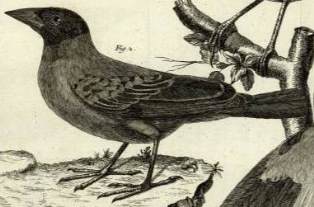
figure from Brisson 1760 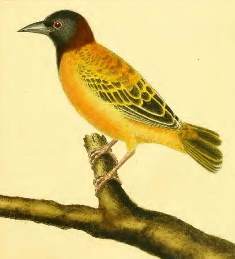
figure from Daubenton 1783 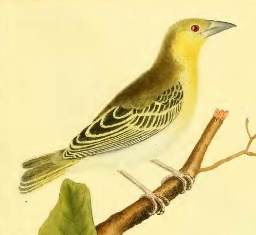
figure from Daubenton 1783 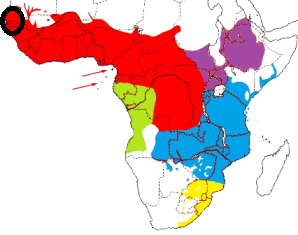
type locality circled IntroductionThe Village Weaver was described by Philipp Ludwig Statius Muller in 1776. Statius Muller was a German zoologist who published a German translation of Linnaeus's Natursystem. The supplement in 1776 contained the first scientific classification for a number of species, including that of the Village Weaver. Statius Muller gives his source as Buffon, a French naturalist who was the director at the Jardin du Roi, now called the Jardin des Plantes.Although Linnaeus had access to the bird descriptions in Brisson 1760, strangely he did not describe the Village Weaver in his 12th edition. Buffon based his work largely on that of Mathurin Jacques Brisson. Brisson gave the first names ever to the Village Weaver, as "Le Pincon du Senegal" (French) and Fringilla senegalensis (Latin). Brisson noted that the Village Weaver originated from Senegal, from where it had been sent to RAF de Reaumur in France by Michel Adanson, who also collected the Red-billed Quelea. The first colour illustration of the Village Weaver is in the book by Edme-Louis Daubenton, containing coloured engravings by Francois-Nicolas Martinet. Scientific citationOriolus cucullatus Statius Muller 1776 Natursyst., Suppl., p.87 Senegal.Meaning of namescucullatus (Late Latin) hooded (L. cucullus, a hood or cowl).First English nameWeever Oriole (Latham 1782)Alternate namesBlack-headed Weaver, Black-hooded Weaver, Layard's Black-headed Weaver, Mottled Weaver, Mottled-backed Weaver, Spot-backed Weaver, Spotted-backed Weaver, V-marked Weaver.CollectorMichel Adanson, a French naturalist who undertook a collecting expedition to Senegal.Date collectedBetween 1748-1754, the time that Adanson spent in Senegal.Locality collectedSenegal.Type specimensNo type specimens known to survive, but the painting of Brisson serves as a type. |
The above is based on Weaver Wednesday 2, a weekly series about the discovery of each weaver species.
This species text first appeared as
Weaver Wednesday [127] - Discovery [10]: Village Weaver on 2014-11-19
1. Basic biology
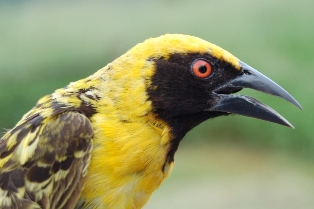
spilonotus 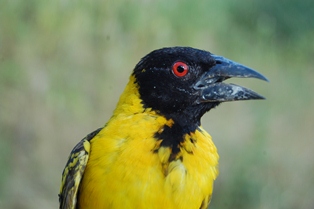
nigriceps 
cucullatus 
collaris
Identification. The Village Weaver is one of the most common, widespread weaver species. It is larger than most weavers, with a red eye in both sexes and a heavy black bill. The plumage varies through its wide range (see also subspecies below). The breeding male has the head mainly black (except the crown is yellow in spilonotus); the nape, hind neck and breast below the black throat are chestnut in West Africa and yellow elsewhere. The back is either yellow with a black "V" formed by the scapulars (West Africa to Ethiopia) or spotted. The male Speke's Weaver P. spekei has a pale yellowish eye, and a very different song. The breeding female is yellow below, and whiter on belly; most subspecies have a yellow superciliary stripe. The non-breeding birds are duller than the breeding female. Distribution.
Habitat. The Village Weaver inhabits bushy savanna, riverine woodland, wetlands, cultivated areas, rural villages, urban and suburban gardens, and villages and clearings in forest. It is frequent associated with human habitation in west and central Africa. It is absent from arid regions, dense forest, and miombo woodland. Food. Its diet is seeds, including grass seeds and cultivated cereals. It is regarded as a pest in rice-growing areas, and also damages maize, sorghum and durra crops. It also feeds on fruit, nectar, and insects, such as beetles, ants, termites and their alates, grasshoppers, mantids, caterpillars, and bugs. It forages by gleaning vegetation, including tree trunks, and visits feedlots. Experiments with captive birds indicate that it uses colour to discriminate between different seed types, rejecting bitter-flavoured varieties. The Village Weaver is gregarious, being found in large flocks; and in the non-breeding period joins large communal roosts. Breeding. The Village Weaver is polygynous, with up to five females simultaneously on the territory of a male, and up to seven during a season. Females may change mates in a season, e.g. one ringed female was successively mated to three different males. It is highly colonial, with more than 200 nests in a single tree and colonies in excess of 1000 nests. The numbers of nests per territory (3-4) is similar in dense and sparse colonies. Larger colonies appear to be more attractive to females, with a higher proportion of females per male. It often breeds in mixed colonies with other weaver species.
When females enter a colony, males hang below their nest entrances while giving nest-invitation calls and flapping their wings to show the yellow underwings. The nest is spherical, sometimes with a very short entrance tunnel. The nest is woven by the male within a day, generally from strips torn from reed or palm leaves. The male often includes a ceiling layer of broad leaves. The female lines an accepted nest with leaves, grass-heads and some feathers. Nests are suspended from drooping branches (usually 6-18 m above the ground), supported at the sides by reeds (1-2 m above the water), or occasionally hanging from telephone lines. Some colonies are placed in heronries or attached to the nests of raptors. A single male may build more than 20 nests in a season, and unused or old nests are regularly destroyed to make space for new nests. Empty nests may be occupied by other animals, including snakes, wasps, mice and bats, and nests may be used for breeding by a wide variety of species including Cut-throat Finches Amadina fasciata.
The eggs are white, pale green or blue, either plain or variably marked with red-brown speckling. Incubation is by the female only, for about 12 days. The chicks are usually fed by the female alone, but males in some parts help. The Village Weaver is regularly parasitized by Diederik Cuckoos Chrysococcyx caprius. Female Village Weavers recognize their own egg pattern, which are constant throughout her life, and discriminate against non-matching eggs. Nest predators include snakes, especially boomslang Dispholidus typus, monkeys and baboons, crows and raptors. The longevity record is 14 years in the wild and 24 years in captivity (see more weaver longevities here. |
The above is based on Weaver Wednesday, a weekly series about weaver species.
This species text first appeared as
Weaver Wednesday [63]: Village Weaver on 2013-08-28
2. Breeding facts
| Pair bond Polygynous, up to five females simultaneously on territory, seven during a season; females may change mates Breeding season Jul-Oct in Mauritania, May-Nov in Senegal and Gambia, Sept-Apr in Liberia, Jul-Aug inland in Ghana (Feb-Mar on coast), Jan-Oct in Togo, Jul-Oct in Mali and Burkina Fasso, Jun/Jul-Aug in Niger and S Nigeria (Sept-Oct peak period in N Nigeria), in all months (peak May-Aug) in Cameroon, Nov-Jan on Bioko and Sao Tome, May-Jun in Central African Republic, and throughout year in Gabon; in DRCongo, Oct-Nov in S, throughout year in Kivu, Sept-Mar in SE, Oct-May in ltombwe, Dec-May in W; Nov-Dec and Mar-May in Rwanda; Mar and Aug-Dec in Sudan, all months except Nov-Dec and Feb in Ethiopia; throughout year (peaks Feb-May and Oct-Nov) in Uganda; in Kenya, Jul on coast, throughout year (peaks Apr-May, Aug-Nov) inland; Oct, Dec-Jun in Tanzania, Sept-Mar in Zambia and Zimbabwe, Oct-Apr in Malawi, Jan-Mar in Botswana, Aug-Mar in Mozambique, and Aug-Feb in South Africa; also, introduced population breed Jun-Feb on Reunion and Mauritius and Dec-Jun in West Indies Nest site may be suspended from drooping branches or supported at sides by reeds, and usually 6-18 m above ground but in tall forest trees can be as high as 30 m, and in wetlands only 1-2 m above water; in Uganda favours giant bamboo (Bambuseae) Nest building woven by male within c. 11 hours, female lines nest Colony size Highly colonial, with more than 200 nests in a single tree and colonies in excess of 1000 nests... but numbers of nests per territory (3-4) similar in dense and sparse colonies Clutch size 2-4 eggs in S Africa, usually 2 in tropics Egg colour white, pale green or blue, either plain or variably marked with red-brown speckling (in Nigeria, some indication that blue eggs with reduced markings more common in mixed colonies dominated by P. nigerrimus, which generally lays unmarked blue eggs) Egg size average size of 180 eggs 23.1 x 14.9 mm (South Africa) Incubation incubation by female only, period c. 12 days in wild, 14 days recorded in captivity Chicks and nestling period chicks usually fed by female alone, in South Africa, Ethiopia and DRCongo male sometimes contributing, nestling period 17-21 days (both in wild and in captivity) |
Breeding information based on Handbook of the Birds of the World, Vol. 15.
3. Photos of Weaver Nests
 Vm 31030 |  Vm 31004 |  Vm 30706 |  Vm 30705 |  Vm 30704 |  Vm 30682 |
Thumb-nails of most recent PHOWN records - click on one to see its full record
See all PHOWN records for this species here.
PHOWN (Photos of Weaver Nests) provides valuable info on breeding distribution and colony sizes of weavers.
You can contribute by registering and submitting photos at Virtual Museum webpage.
4. Breeding distribution
Google map showing distribution (For species with small ranges you need to zoom in at the correct area to see the range):
yellow blob - range of weaver species; read more about this here.
![]() - PHOWN records with photos
- PHOWN records with photos
![]() - PHOWN records with no photos (Nest Record Cards, other records)
- PHOWN records with no photos (Nest Record Cards, other records)
![]() - Birdpix records
- Birdpix records
![]() - comments on out of range records, or interesting records
- comments on out of range records, or interesting records
![]() - type locality
- type locality
CLICK on the marker on the map to see individual record details.
5. Range changes
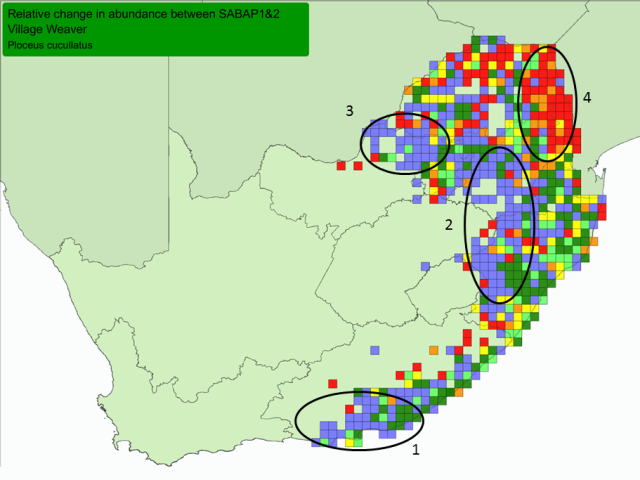
Red, orange and yellow = cells with very large, large, and small relative decreases Blue, dark green and light green = cells with very large, large and small relative increases. Cells = quarter-degree grid cells; Only cells with at least 4 checklists in both SABAP1&2 shown. All cells had this species recorded in SABAP1 or in SABAP2 or in both (more about interpretation at Biodiversity Observations 7.62: 1-13).
Range changes in SA
The points below match the points on the map above. Areas with very large increases include:
Areas with very large decreases:
Range changes elsewhereSudan: now breeding resident around Khartoum; some records along Nile further north (Demey 2014b). | |||||||||||||||||||||||||||||||||||
The above is based on Weaver Wednesday 3, a weekly series about range changes in South African weaver species.
This species text first appeared as
Weaver Wednesday 3 [246] - Range changes [9]: Village Weaver on 2017-03-01







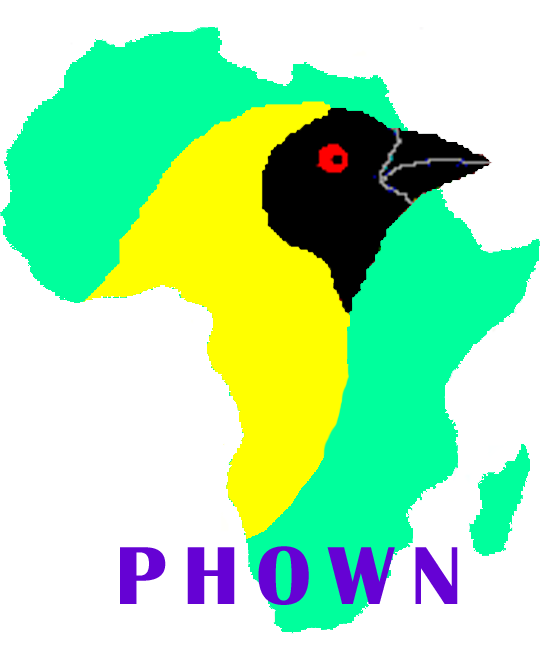
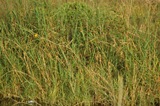


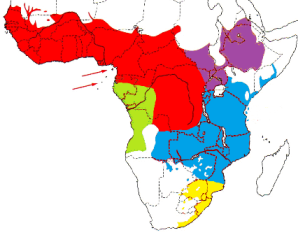 The Village Weaver is widespread in sub-saharan Africa except in the arid south-west and north-east. Five subspecies of the Village Weaver are recognised (see map left, based on
The Village Weaver is widespread in sub-saharan Africa except in the arid south-west and north-east. Five subspecies of the Village Weaver are recognised (see map left, based on 


